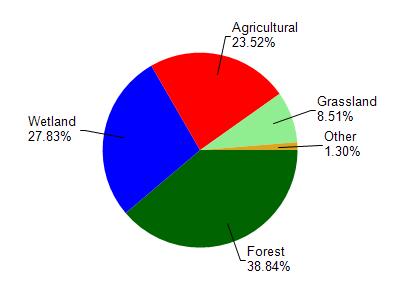Taylor
No
No
Yes
Fish and Aquatic Life
Overview
This 49 acre drainage lake has a good fishery with a naturally reproducing walleye population. However, a fish consumption advisory exists for walleye over 15 inches for mercury (WDNR, 1997). Since only walleye were previously sampled, other game species present in significant numbers should be collected for fish tissue analysis (Amrhein). There is a fair amount of agricultural activity around Diamond Lake and summer algae blooms are common. Comprehensive water quality information is lacking for Diamond Lake. Training a self-help volunteer and a lakes planning grant would add to the limited water quality database of this lake (Ryan).
Date 1999
Author Aquatic Biologist
Historical Description
Diamond Lake is a soft water, drainage lake located on a feeder to McKenzie Creek. The estimated normal flow of the outlet is 1.0 cubic foot per second. A two-foot head rock roller dam at the outlet maintains the water level at its present height. Summer algae blooms are common, but are not considered to be a problem. The fish population consists of northern pike, walleye, largemouth bass, perch, bluegill, black crappies, rock bass, pumpkinseed, black bullhead, carp, and white suckers. Approximately 50 percent of the shoreline is pasture, with the remainder being upland hardwood and marsh. The littoral zone is about one-half muck with the remaining part being mostly rubble and gravel. Aquatic plants noted here include pickerel weed, cattail, yellow and white water lilies, watershield, coontail, and green algae. Muskrat use is significant, but there are no beaver present. Waterfowl use is minor. A town park on the west shore provides the only public access to the lake. There are facilities for picnicking and camping, a beach, and a boat launching ramp. There is no private development.
Source: 1970, Surface Water Resources of Taylor County Diamond Lake, T30N, R3W, Section 1 Surface Acres = 48.95, Maximum Depth = 30 feet, M.P.A. = 46 ppm, Secchi Disk = 5 feet.
Date 1970
Author Aquatic Biologist
Condition
Wisconsin has over 84,000 miles of streams, 15,000 lakes and milllions of acres of wetlands. Assessing the condition of this vast amount of water is challenging. The state's water monitoring program uses a media-based, cross-program approach to analyze water condition. An updated monitoring strategy (2015-2020) is now available. Compliance with Clean Water Act fishable, swimmable standards are located in the Executive Summary of Water Condition in 2018. See also the 'monitoring and projects' tab.
Reports
Management Goals
Wisconsin's Water Quality Standards provide qualitative and quantitative goals for waters that are protective of Fishable, Swimmable conditions [Learn more]. Waters that do not meet water quality standards are considered impaired and restoration actions are planned and carried out until the water is once again fishable and swimmable
Management goals can include creation or implementation of a Total Maximum Daily Load analysis, a Nine Key Element Plan, or other restoration work, education and outreach and more. If specific recommendations exist for this water, they will be displayed below online.
Monitoring
Monitoring the condition of a river, stream, or lake includes gathering physical, chemical, biological, and habitat data. Comprehensive studies often gather all these parameters in great detail, while lighter assessment events will involve sampling physical, chemical and biological data such as macroinvertebrates. Aquatic macroinvertebrates and fish communities integrate watershed or catchment condition, providing great insight into overall ecosystem health. Chemical and habitat parameters tell researchers more about human induced problems including contaminated runoff, point source dischargers, or habitat issues that foster or limit the potential of aquatic communities to thrive in a given area. Wisconsin's Water Monitoring Strategy was recenty updated.
Grants and Management Projects
Monitoring Projects
| WBIC | Official Waterbody Name | Station ID | Station Name | Earliest Fieldwork Date | Latest Fieldwork Date | View Station | View Data |
|---|
| 1757200 | Diamond Lake | 10019377 | Diamond Lake -- Access | 9/10/2013 | 8/17/2019 | Map | Data |
| 1757200 | Diamond Lake | 10005813 | Diamond Lake | 6/2/1997 | 7/13/2020 | Map | Data |
| 1757200 | Diamond Lake | 613188 | Diamond Lake - Max Depth | | | Map | Data |
|

Watershed Characteristics
Diamond Lake is located in the Trappers and Pine Creeks watershed which is 134.31 mi². Land use in the watershed is primarily forest (38.80%), wetland (27.80%) and a mix of agricultural (23.50%) and other uses (9.80%). This watershed has 181.16 stream miles, 550.88 lake acres and 15,489.14 wetland acres.
Nonpoint Source Characteristics
This watershed is ranked Low for runoff impacts on streams, Not Available for runoff impacts on lakes and Medium for runoff impacts on groundwater and therefore has an overall rank of Medium. This value can be used in ranking the watershed or individual waterbodies for grant funding under state and county programs.However, all waters are affected by diffuse pollutant sources regardless of initial water quality. Applications for specific runoff projects under state or county grant programs may be pursued. For more information, go to surface water program grants.